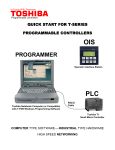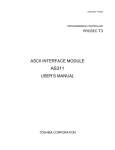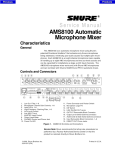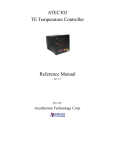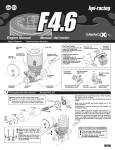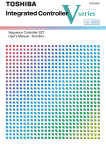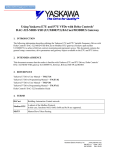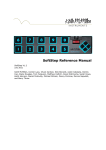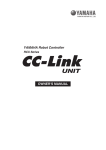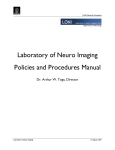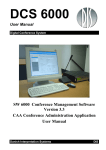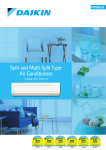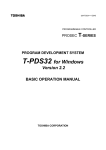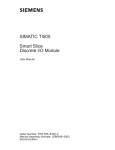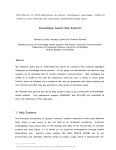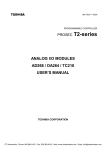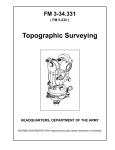Download OIS10 & OIS15 Series
Transcript
In Touch With Tomorrow Programmable Controllers QUICK START FOR TT-SERIES PROGRAMMABLE CONTROLLERS OIS PROGRAMMER Operator Interface Station PLC Toshiba Notebook Computer (or Compatible) with T-PDS Windows Programming Software RS232 Cable Toshiba T1 Small Micro Controller COMPUTER TYPE SOFTWARE----INDUSTRIAL TYPE HARDWARE HIGH SPEED NETWORKING Phone: 800.894.0412 - Fax: 888.723.4773 - Web: www.ctiautomation.net - Email: [email protected] T-SERIES QUICK START TABLE OF CONTENTS INTRODUCTION.......................................................................................................................1 Quick Start .......................................................................................................................................................... 1 Specific References ........................................................................................................................................... 2 General References............................................................................................................................................ 2 Disclaimer ........................................................................................................................................................... 2 THE BASICS ............................................................................................................................3 Programming Instructions................................................................................................................................. 3 Recommended Steps for Programming........................................................................................................... 5 On-Line/Off-Line Programming......................................................................................................................... 6 Switching Between Halt and Run ................................................................................................................... 10 END STATEMENT-- EXAMPLE 1 ..........................................................................................11 Clear Memory--Step 1....................................................................................................................................... 11 Perform the I/O Allocation--Step 2 .................................................................................................................. 12 Set the Retentive Memory Area--Step 3 ......................................................................................................... 14 Program the END Statement--Step 4 & Step 5............................................................................................... 17 Test the Program in the PLC--Step 6.............................................................................................................. 20 Save the Program--Step 7................................................................................................................................ 20 DELAYED START--EXAMPLE 2............................................................................................21 OTHER PROGRAMMING EXAMPLES ..................................................................................33 Cycling Output.................................................................................................................................................. 34 One Input Start-Stop Push Button.................................................................................................................. 35 Permissive Start ............................................................................................................................................... 36 External Register Adjustment ......................................................................................................................... 38 Simple Math ...................................................................................................................................................... 39 Data Exchange.................................................................................................................................................. 45 Page 2 Phone: 800.894.0412 - Fax: 888.723.4773 - Web: www.ctiautomation.net - Email: [email protected] T-SERIES QUICK START OPERATOR INTERFACE STATION —OIS10 & OIS15 ........................................................49 How the OIS Works .......................................................................................................................................... 50 The OIS Basics ................................................................................................................................................. 51 Embedded Variables in Messages.................................................................................................................. 54 Data Entry.......................................................................................................................................................... 58 SUMMARY: ............................................................................................................................72 APPENDIX A T-PDS WIN MENU STRUCTURE ................................................................73 APPENDIX B T-PDS WIN SHORTCUT KEYS ...................................................................81 APPENDIX C ADDRESSING & I/O ALLOCATION ..........................................................85 TELL IT TO TOSHIBA............................................................................................................89 Page 3 Phone: 800.894.0412 - Fax: 888.723.4773 - Web: www.ctiautomation.net - Email: [email protected] T-SERIES QUICK START INTRODUCTION Quick Start Purpose: This Quick Start is for users and potential users of Toshiba’s T-Series Programmable Controllers Operator Interface Stations. These controllers include: µControllers—T1-16, T1-28, & T1-40. Medium Controllers—T2E & T2N Large System Controllers—T3 & T3H. Operator Interface Stations—OIS10/15 Since these controllers all use the same instruction set and the same T-PDS Windows programming software, the T1-16 (8 inputs & 8 outputs) will be used for all the sample circuits in this Quick Start. Any information learned about the T1-16 is applicable to all T-Series controllers and any examples created and tested on the T1-16 can be transferred and run on any other T-Series controller. Required Equipment: The Toshiba T-Series Programmable Controllers are very easy to program. This Quick Start will show how to setup a T-Series controller and how to enter simple programs. It assumes that the following is available: •= A Toshiba notebook computer (or compatible) with a minimum of a 486 processor, VGA graphics card, and: •= MS Windows 3.1 with 12 Mb RAM •= Windows95 with 16 Mb RAM. •= T-PDS Windows, the T-PDS Windows programming software installed on the above computer. •= TDR116-6S, a 24 Vdc input T1-16 controller. •= TKRS232T1, the RS232 connection cable for connecting the T1 to the computer. •= OIS10, a two line x 16 character Operator Interface Station (Optional). With this equipment, program examples can be verified for correct operation by simulating inputs and observing expected outputs. Page 1 Phone: 800.894.0412 - Fax: 888.723.4773 - Web: www.ctiautomation.net - Email: [email protected] T-SERIES QUICK START Specific References Toshiba recommends that each user familiarize himself/herself with the Users Manual for the specific controller that is to be used prior to attempting any programming. This Quick Start represents the bare minimum of knowledge necessary to setup a simple program in a TSeries PLC. As such, it is best used for a review after study of the Users Manual. It can be used, however, when time is critical and it is necessary to setup the controller and write a program without prior study. Technical Documentation, T1 USERS MANUAL-Basic Hardware and Function, 3rd edition, Tokyo, Japan: Toshiba Corporation. 1996. Order number UM-TS01-E001. Dropka, Ed. An Introduction to Medium Programmable Logic Controllers and Relay Ladder Logic, Tom Bean, TX. Country Squire. 1992. 903-364-2365 General References Bryan, L. A. and Bryan, E. A. Programmable Controllers, Theory & Implementation, Marietta, GA. Industrial Text & Video. 1996. 800-752-8398. Hughes, T. A. Programmable Controllers, Research Triangle Park, NC, Instrumentation Society of America (ISA). 1989. ISBN: 1-55617-166-8 A. 919-5498411. Kissell, T. E. Understanding & Using Programmable Controllers, West Nyack, NY. Prentice-Hall Inc. 1987 Disclaimer The examples used in this Quick are no more than simple examples. TOSHIBA GIVES NO WARRENTY, EXPRESS OR IMPLIED, AS TO THE FITNESS OF THESE EXAMPLES FOR ANY PARTICULAR PURPOSE. TOSHIBA SHALL BE IN NO WAY BE RESPONSIBLE THEIR PROPER USE. Page 2 Phone: 800.894.0412 - Fax: 888.723.4773 - Web: www.ctiautomation.net - Email: [email protected] T-SERIES QUICK START The The Basics Programming Instructions T-Series programmable controllers can handle a wide variety of control applications from the very simple to the very complex. They can be programmed using one (or any combination of) the following: •= Relay Ladder Logic •= Function Blocks •= Sequential Function Chart (SFC) (Not Available on T1) •= Relay Ladder Logic (RLL): Symbol Description / I Normally Open Normally Closed Invert Symbol Description —( )— x—( )— —( )— —[End] Coil Forced Coil Invert Coil End of Program Contacts Symbol ↑ ↓ Description Positive Edge Transitional Negative Edge Transitional Coils Symbol —[MCS]— —[MCR]— —[JCS]— —[JCR]— Description Master Control Set Master Control Reset Jump Control Set Jump Control Reset Page 3 Phone: 800.894.0412 - Fax: 888.723.4773 - Web: www.ctiautomation.net - Email: [email protected] T-SERIES QUICK START Symbol Timers & Counters Description Symbol [A TON B] [A TOF B] [A SS B] On Delay Timer Off Delay Timer Single Shot Timer ╶⌈ CNT ⌉╴ │ │ ╶⌊A B⌋ ⌋ ╶⌊ Description Counter For information on how to enter relay ladder devices from the tool bar, see “Enter the normally open contact X0” on page 23. •= Function Blocks: Function blocks, as the name implies, are blocks that are inserted into the relay ladder logic. When power flow reaches the block, an action is performed. There are data transfer function blocks, arithmetic function blocks, compare function blocks, etc. The basic format for a function block is: [ A + B → C ] C = Any legal destination register/device. B = Any legal source register/device. A = Any legal source register/device. In the above example, the contents of A and B are added and the result is placed in C. For a list of all legal registers/devices for each function block, see the instructions section of the Users Manual. It is not necessary for a line of logic to end in a coil; it can also end in a function block. Coils are sometimes necessary at the end of a function block, such as a compare function block, to take action on the result of the function block operation. •= Sequential Function Chart (SFC): SFC is a form of flow chart programming. It can be very useful for trouble shooting complicated programs. See the section on SFC in the Users Manual for a detailed description of SFC as it is implemented in T-Series Controllers. Page 4 Phone: 800.894.0412 - Fax: 888.723.4773 - Web: www.ctiautomation.net - Email: [email protected] T-SERIES QUICK START Recommended Steps for Programming Initial programming can be started from many different points. A good sequence to follow is: Initialization Clear Memory. Step 1. Perform the I/O Allocation. Step 2. Set the Retentive Memory Area. Step 3. Program the End Statement. Step 4. Program Write the Program. Step 5. Test Test the Program in the PLC Step 6. Save Save the Program to EEROM/Disk Step 7. The PLC must be On-Line for this sequence to be followed. Included in this quick start are two examples that demonstrate these steps. •=END Statement Entering the END circuit, saving it to RAM, then to EEPROM •=Delayed Start A simple ladder logic circuit using standard ladder symbols. Page 5 Phone: 800.894.0412 - Fax: 888.723.4773 - Web: www.ctiautomation.net - Email: [email protected] T-SERIES QUICK START On-Line/Off-Line Programming The T-PDS Windows programming software has two separate types of programming: •= On-Line •= Off-Line In On-Line Programming, the computer is connected to the T-Series controller directly, either through the programming port, the computer link port, or a network card. All of the following examples will be done with the T-PDS software On-Line connected to the programming port. When the T-PDS software is On-Line, any program created, edited, or modified is saved into the controller’s memory (RAM/EEPROM). On-Line Programming is selected from the PLC menu. Check here to verify the controller is Off-Line. Click here to toggle On-Line The On-Line/Off-Line selection is a toggle. If the controller is Off-Line, clicking on this selection causes it to switch to On-Line. If the controller is On-Line, clicking on this selection causes it to switch to Off-line. Page 6 Phone: 800.894.0412 - Fax: 888.723.4773 - Web: www.ctiautomation.net - Email: [email protected] T-SERIES QUICK START In Off-Line Programming the computer is not connected to a controller. This is also called stand alone programming. When the T-PDS software is Off-Line, any program created, edited, or modified is saved on the computer’s hard disk or to a floppy disk. The steps for Off-Line Programming are: •= Create a New Project or •= Open an Existing Project •= Write, Edit, or Modify a Program •= Save the Program to Disk New Project: All actions in T-PDS (Toshiba-Program Development Software) windows are initiated from the main window. The first step is to open a new project and select a PLC type. Select New Project Select the PLC type and click OK. Most selections are obvious. See Appendix A for a description of the drop down selection from the Windows menu. Page 7 Phone: 800.894.0412 - Fax: 888.723.4773 - Web: www.ctiautomation.net - Email: [email protected] T-SERIES QUICK START Open an Existing Project: Click Open Project Select the Project to Open Click Ok Note: This is the standard method for opening saved files in MS Windows. Page 8 Phone: 800.894.0412 - Fax: 888.723.4773 - Web: www.ctiautomation.net - Email: [email protected] T-SERIES QUICK START Save the Program to Disk: Create, Edit, or Modify a program, then save it. Click here for Save As Type the name of the new project Click Ok Note: The Save As Box is the standard MS Windows Saves as dialog box. 1st Make sure the correct Drive is displayed. 2 nd Make sure that the correct Subdirectories are selected. 3rd Make sure the Save File As Type is correct. 4th Add a File Comment (Optional). Page 9 Phone: 800.894.0412 - Fax: 888.723.4773 - Web: www.ctiautomation.net - Email: [email protected] T-SERIES QUICK START Switching Between Halt and Run The controllers have several Modes or states. These are selected by clicking on PLC Control from the main PLC menu. The two most commonly used Modes are Run (User program is being executed) and Halt (all operations are stopped). Setup and most editing are performed with the controller in the Halt Mode. To put the controller in the Halt Mode: 1. Use the PLC Control Menu Or 2. The Run/Halt switch on the controller. These actions can only be performed when the controller is in the Halt Mode: •= Memory Clear •= I/O Allocation •= Write EEPROM •= Error Reset A controller can only execute its program when it is in the Run or Forced Run Mode. Page 10 Phone: 800.894.0412 - Fax: 888.723.4773 - Web: www.ctiautomation.net - Email: [email protected] T-SERIES QUICK START END STATEMENT-STATEMENT-- EXAMPLE 1 Example 1 is a simple example of doing a complete program. It consists of initialization, entering the END statement, then testing and saving the END statement. Clear Memory--Step 1. When Memory Clear is performed, the contents of the RAM are cleared. This is generally done when it is desired to initialize the CPU. Clear Memory does the following: 1. Erases any program in the RAM. 2. Erases the I/O Allocation. 3. Erases any setup data on the System Parameters Screen Clear Memory Screen: Click here Page 11 Phone: 800.894.0412 - Fax: 888.723.4773 - Web: www.ctiautomation.net - Email: [email protected] T-SERIES QUICK START Perform the I/O Allocation--Step 2 I/O allocation is always necessary for a T2 or T3 system. It is also necessary for a T1-40 when it is using expansion I/O. I/O allocation is done automatically for a basic T1 after Memory Clear when in the on-line mode. Auto I/O Allocation is performed from the Top Menu as follows: I/O Allocation Screen: Page 12 Phone: 800.894.0412 - Fax: 888.723.4773 - Web: www.ctiautomation.net - Email: [email protected] T-SERIES QUICK START Screen Result: T1 controller (no expansion) I/O allocation. Minimum Configuration for T1 with no expansion I/O ON LINE:: Click here OFF LINE:: Click here Note: I/O Allocation for the T1 controllers is performed automatically after memory is cleared, therefore, if only the base controllers are used (no expansion I/O cards, units or modules) I/O Allocation is not necessary. I/O Allocation is always necessary on modular controllers like the T2 & T3. Manual I/O Allocation Manual I/O Allocation is started by the same method as Auto I/O Allocation. From the screen above choose Setup. A menu will then appear which will allow: A register type (Input, Output, Tosline, etc.) to be assigned to each slot. and The number of registers (1, 2, 4, etc.) to be assigned to that slot. Page 13 Phone: 800.894.0412 - Fax: 888.723.4773 - Web: www.ctiautomation.net - Email: [email protected] T-SERIES QUICK START Set the Retentive Memory Area--Step 3 The retentive memory area determines which Auxiliary Registers (RW), Timer Registers (T), Counter Registers (C), and Data Registers (D) will hold their current value when power is cycled. For example, if Counter C10 is in the retentive area, it will hold its current count value when power is cycled. If Counter C11 is in the non-retentive area, its current count value will be reset to “0” when power is cycled. Setting the Retentive Memory Area is performed on the System Parameters Screen. Select System Parameter Screen: Result, the system parameters screen. Page 14 Phone: 800.894.0412 - Fax: 888.723.4773 - Web: www.ctiautomation.net - Email: [email protected] T-SERIES QUICK START Select Retentive Memory Area Screen Setup Retentive Memory Screen Page 15 Phone: 800.894.0412 - Fax: 888.723.4773 - Web: www.ctiautomation.net - Email: [email protected] T-SERIES QUICK START After the above setting has been made, Auxiliary Registers 0 - 25 are retentive, no Timer Registers are retentive, Counter Registers 0 - 10 are retentive, and Data Registers 0 - 700 are retentive. Any registers not in the retentive range are non-retentive. Note 1: Data Registers D0 - D511 are stored in EEPROM each time the “Write EEPROM” command is executed. But, for the values in this register to be available at power up or when the controller is switched to the Run Mode, D0 – D511 must be setup as retentive. Note 2: While on the System Parameters Screen, it is a good idea to go to Item 1, Program ID and give the program a unique name (combination of eight alpha numeric characters). This name is stored in EEPROM and will always be part of the program regardless of where the program is stored (in the controller, on disk, etc). See ID & Comments on the Systems Parameters Screen (previous screen). At this point the controller is “setup”. Now it is a matter of simply entering a program, testing the program, and saving it (to EEPROM). First, make sure the controller is in the “Halt Mode”. Do this using: 2. The PLC Control Menu Or 2. The Run/Halt switch on the controller. Page 16 Phone: 800.894.0412 - Fax: 888.723.4773 - Web: www.ctiautomation.net - Email: [email protected] T-SERIES QUICK START Second, go to Main Program Block 256 by selecting Search, then Goto: Select Main Program and Block No. 256 in the GoTo box, then OK: Program the END Statement--Step 4 & Step 5. T-Series programming is very flexible. Programs are entered into Blocks. 1. The whole program (until all program memory is used) can be put into Block 1, or 2. The program can be spread out over 256 Blocks (the Blocks do not have to be consecutive). It is recommended for ease of programming that the END statement be placed in Block 256 (but it is not required). For the End Statement example, the End Statement will be put in Block 256. Page 17 Phone: 800.894.0412 - Fax: 888.723.4773 - Web: www.ctiautomation.net - Email: [email protected] T-SERIES QUICK START To program the End Statement: Make sure the controller is in “Halt” and select the Edit Mode. Edit Mode Select Screen: Selection Result: Page 18 Phone: 800.894.0412 - Fax: 888.723.4773 - Web: www.ctiautomation.net - Email: [email protected] T-SERIES QUICK START Click “End” on the Instruction Menu then click the target box in the ladder area. This completes line 1 of Circuit 1. The screen should appear as follows: Select Write from the Edit Menu. This transfer the program created on the computer to the controller’s Random Access Memory (RAM). The End Statement has now been programmed in Block 256. Page 19 Phone: 800.894.0412 - Fax: 888.723.4773 - Web: www.ctiautomation.net - Email: [email protected] T-SERIES QUICK START Test the Program in the PLC--Step 6. In this example with the END statement, testing is very easy. Put the controller in the RUN mode. If nothing happens, the program is ok. If the controller goes into the error mode, then the END statement was not correctly entered or the I/O allocation was not properly set. Save the Program--Step 7. At present the program (just the END statement) only exists in the controller’s RAM (Random Access Memory). When power is cycled, the program in RAM will be lost. It will be replaced by whatever is contained in the built-in EEPROM (Electrically Erasable Programmable Read Only Memory). If this is the 1st time the unit has been programmed and power is cycled, it will appear that the CPU has “lost its program” (since the EEPROM is blank). The user program, in RAM, can be made secure by writing it to the internal EEPROM. Write the program to EEPROM by the following method. For the other two methods of securing a program, please consult the user’s manual. Screen: Click on “Write EEPROM/IC Card” to save the user program from RAM into EEPROM Page 20 Phone: 800.894.0412 - Fax: 888.723.4773 - Web: www.ctiautomation.net - Email: [email protected] T-SERIES QUICK START Delayed Start-Start--Example --Example 2 Exercise: Write a program that will cause a second output, Y022 to turn ON 15 seconds after the first output Y021, turns ON. Use X000 to turn the outputs ON and X001 to turn the outputs OFF. Schematic: Entry Sequence: Circuit 1 (Note: The words circuit and rung are used interchangeably.) First, go to Block 1 Enter 1 for Block No., then click OK When block 1 is selected, click on Edit, Edit Mode, then depending on the PLC Mode, select: Page 21 Phone: 800.894.0412 - Fax: 888.723.4773 - Web: www.ctiautomation.net - Email: [email protected] T-SERIES QUICK START Select the programming language, always select ladder for the T1. Result Page 22 Phone: 800.894.0412 - Fax: 888.723.4773 - Web: www.ctiautomation.net - Email: [email protected] T-SERIES QUICK START The T-PDS software is now in the Edit Mode. It is not communicating with the controller. Note: •= The ladder logic tool bar is now visible. •= The circuit (rung) where the first line of logic will be entered is highlighted. •= The cursor (rectangle) is located at the first position in circuit 1. The following procedure is used to create the ladder program. •= Click on the desired element (contact, coil, timer, etc.) in the ladder tool bar. •= Click on the cursor location (the element selected on the ladder tool bar is entered at the cursor location). •= Type in the device address. •= Press enter (the cursor will advance horizontally to the next entry position or the next position maybe selected by clicking on the desired location). Enter the normally open contact X0 Click here. Then click here Then type X0 and press enter Page 23 Phone: 800.894.0412 - Fax: 888.723.4773 - Web: www.ctiautomation.net - Email: [email protected] T-SERIES QUICK START Result Enter the normally closed contact X1. Click here Then click here Then type X1 and press enter. Result Page 24 Phone: 800.894.0412 - Fax: 888.723.4773 - Web: www.ctiautomation.net - Email: [email protected] T-SERIES QUICK START Enter the output coil Y21 Click here Then click here They type Y21 and press enter Result Page 25 Phone: 800.894.0412 - Fax: 888.723.4773 - Web: www.ctiautomation.net - Email: [email protected] T-SERIES QUICK START Enter the vertical down connections to line 2. Reposition the cursor so that it is on normally open contact X0. Click here Then click here Then move the cursor over X1 and repeat Result Note: The vertical down connections do not have to be entered separately as was just done. A more efficient way to enter the vertical down connections is at the same time the device (normally closed contact, open contact, etc.) is entered. After entering the device, click the vertical down symbol and then click on the cursor position again. Page 26 Phone: 800.894.0412 - Fax: 888.723.4773 - Web: www.ctiautomation.net - Email: [email protected] T-SERIES QUICK START Enter the normally open (seal-in) contact Y21 on line 2. Move the cursor to the first position on line 2. Click here. Then click here. Then type Y21 and press enter. Result Page 27 Phone: 800.894.0412 - Fax: 888.723.4773 - Web: www.ctiautomation.net - Email: [email protected] T-SERIES QUICK START Click “Next” on the ladder tool bar to display the TON button. Enter Timer T35 and set the time for 15 seconds (150). Click here Then click here Then type 150 to the left of TON, T35 to the right of TON, and press enter Result This completes circuit (rung) 1. Note that it is not necessary to complete the line after timer T35. T-PDS will automatically complete this line when the block is entered into the controller. A line can end in an output coil or a function block ; in this case the on delay timer TON T35. A line can not end in a contact. Page 28 Phone: 800.894.0412 - Fax: 888.723.4773 - Web: www.ctiautomation.net - Email: [email protected] T-SERIES QUICK START Enter the normally open contact T.35 (the done bit for timer T35). First press enter to move the cursor down to the first position in circuit 2. Second click “Prev” to select the previous tool bar display with the normally open contact. Click here Then click here Then type the device address T.35 and press enter Result Page 29 Phone: 800.894.0412 - Fax: 888.723.4773 - Web: www.ctiautomation.net - Email: [email protected] T-SERIES QUICK START Enter the output coil Y22 Click here Then click here Then type Y22 and press enter Result This completes Delayed Start Example. At this point, however, the program is not in the controller. It is only written on the computer screen. Page 30 Phone: 800.894.0412 - Fax: 888.723.4773 - Web: www.ctiautomation.net - Email: [email protected] T-SERIES QUICK START Save the program to the controller. Click on Write to save the program Note: It is not possible to move to another block until the editing done on the current block is saved with the “Write” selection. Page 31 Phone: 800.894.0412 - Fax: 888.723.4773 - Web: www.ctiautomation.net - Email: [email protected] T-SERIES QUICK START Test the Program (Step 6). Select the Run Mode, use the “PLC Control Menu” or move the Run/Halt switch on the PLC into the Run position. Now, verify correct the operation of the Delayed Start Example. ACTION RESULT Momentarily turn X0 ON Output Y21 turns ON Timer T35 starts timing Output Y22 turns ON 15 seconds after output Y21 Momentarily turn X1 ON The seal-in circuit is broken and outputs Y21 and Y22 turn OFF. When Input X0 is turned on, observe the timer, T35 timing from 0 to 150. Inputs X0 and X1 can be momentarily turned ON by making a connection on the input terminal strip between the C terminal and the respective inputs. For testing and training, it is recommended the 24 Vdc input controllers be used. Save the Program to EEPROM (Step 7) As a reminder, this program (the Delayed Start Example) exits only in RAM. As soon as power is cycled on the controller, this program will be lost. To make the program permanent, save it to EEPROM. See “Save the Program--Step 7” on page on page 20. Page 32 Phone: 800.894.0412 - Fax: 888.723.4773 - Web: www.ctiautomation.net - Email: [email protected] T-SERIES QUICK START OTHER PROGRAMMING EXAMPLES The examples that follow are presented as exercises. First a description will be given which requires a specific output(s) from the controller. The input conditions, which cause this output(s), will also be given. Then a RLL (Relay Ladder Logic) diagram will follow which shows one method for achieving the desired output result. The objectives are to: •=Enter the logic diagram into a T1 (or other T-Series controller) using the T-PDS Windows programming software. •=Test the logic diagram by placing the controller in the RUN mode. •=Simulating the input(s) and •=Observing the correct output(s) turn ON/OFF. Note: The logic diagram shown is not the only solution to the exercise. It is just one that works. The following examples will be used: Example Block Used Cycling Output 2 One Input Start-Stop Push Button 3 Permissive Start 3 (Add Logic) External Register Adjustment 4 Pump Sequence, Lead-Lag-Last 5–7 Simple Math 8 Data Setup 9 Page 33 Phone: 800.894.0412 - Fax: 888.723.4773 - Web: www.ctiautomation.net - Email: [email protected] T-SERIES QUICK START Go to main block 2 to enter the example. Cycling Output Description: Create a circuit which will cause output Y023 to cycle ON for 1 second, then OFF for 1 second. Start Y023 cycling when input X002 turns ON. Note: T0 – T31 are 0.01 sec timers. Logic Diagram: Test: Test the circuit. Put the controller in run, and jumper between the input terminal X2 and the C terminal. Does output Y23 cycle ON and OFF every 10 seconds? Additional Requirement: Modify the cycling output circuit so that the circuit will cycle even if input X2 is OFF. Comprehension Question: When is desirable to use D100 as the preset for T0 and D101 (or any set of data registers) as the preset for T1? Hint: Think about using an operator interface unit with the PLC. Page 34 Phone: 800.894.0412 - Fax: 888.723.4773 - Web: www.ctiautomation.net - Email: [email protected] T-SERIES QUICK START Go to main block 3 to enter the example. One Input Start-Stop Push Button Description: Put the controller in the Halt Mode. Create a circuit which will alternately turn output Y024 ON (if it is OFF) or OFF (if it is ON) each time input X003 turns ON. Logic Diagram: Test: Test the circuit. Put the controller into the Run Mode. Momentarily connect a jumper wire from the C terminal on the input terminal strip to X3. Output Y24 should change state each time an input into X3 is made. Comprehension Questions: What other pair of instructions will give the same functionality as the flip-flop? How does output coil Y24 determine if the Set or the Reset input of the flip-flop is selected? Page 35 Phone: 800.894.0412 - Fax: 888.723.4773 - Web: www.ctiautomation.net - Email: [email protected] T-SERIES QUICK START Continue in main block 3 to enter the example Permissive Start Description: Put the controller in the Halt mode. Add a second circuit to the “One Input Start-Stop Push Button example. The “Permissive Start Circuit” will let Y024 turn ON three times. On the 4th try to turn Y024 ON, it will be locked out. It will stay locked out until the reset input, X004, is momentarily turned ON. Logic Diagram: First select the Edit Mode. Then locate the cursor on the rising edge transitional contact. Select the Insert Mode, click on the normally closed contact, then click on the cursor box. Click here Then click here Page 36 Phone: 800.894.0412 - Fax: 888.723.4773 - Web: www.ctiautomation.net - Email: [email protected] T-SERIES QUICK START Result Select the Overwrite Mode (exit the insert mode) and enter circuit 2 as shown. Test the Circuit. Momentarily connect a jumper from the C terminal on the input terminal strip to input X3. Repeat this several times. Output Y24 should turn ON three times then cease to turn ON (because it is locked out). Additional Requirement: Add-to/Modify the permissive start example so that, in addition to the manual reset X002, automatic reset will occur 15 seconds after the third start attempt. Comprehension Question: Why is a trailing edge transitional contact used after normally open contact Y24 in circuit 2? Page 37 Phone: 800.894.0412 - Fax: 888.723.4773 - Web: www.ctiautomation.net - Email: [email protected] T-SERIES QUICK START Go to main block 4 to enter the example. External Register Adjustment Description: Put the controller into the Halt Mode. Write a program that uses external potentiometer (pot) V0 to vary the value in special register SW30. Use the value in SW30 as the preset for timer T10. Adjusting the pot V0 will the output Y0 to cycle ON and OFF at a varying rate, depending on the pot setting. Logic Diagram: Test the Circuit: Connect a jumper from C on the input terminal strip to input X7. Locate pot V0 (next to the connection for the programmer cable) and vary its value with a plus (phillips) screwdriver. Watch the ON and OFF cycle time vary as V0 is varied. Comprehension Questions: What is the minimum and maximum ON time for output Y20? What would the minimum and maximum ON time be if timers T40 and T41 were used instead of T10 and T11? Page 38 Phone: 800.894.0412 - Fax: 888.723.4773 - Web: www.ctiautomation.net - Email: [email protected] T-SERIES QUICK START Enter the following example in main block 8. Simple Math Description: Write a program that will Add, Subtract, Multiple, or Divide two registers and will put the result in D205. Device ON R000C R000D R000E R000F Operation Add Subtract Multiply Divide Source Registers D200=10, D201=5 D200=10, D201=5 D200=10, D201=5 D200=10, D201=5 Destination Register D205=15 D205=05 D205=50 D205=02 Logic Diagram: Page 39 Phone: 800.894.0412 - Fax: 888.723.4773 - Web: www.ctiautomation.net - Email: [email protected] T-SERIES QUICK START Data Setup: There are several ways to enter data into the registers of T-Series controllers. Perhaps the quickest is to use the Data Monitor. Select the Data Monitor as follows: Result: Page 40 Phone: 800.894.0412 - Fax: 888.723.4773 - Web: www.ctiautomation.net - Email: [email protected] T-SERIES QUICK START In the Data Monitor View, select D200 as the starting register. Click here Then click here (set at 6) Then click here (select D for data registers) Then click OK Result: Page 41 Phone: 800.894.0412 - Fax: 888.723.4773 - Web: www.ctiautomation.net - Email: [email protected] T-SERIES QUICK START Enter values into D200 & D201, use the Data Box. Click on Edit, or double click on the specific register to bring up the DataBox. Enter the following: Double click here Then enter 5 here. Then click set here Page 42 Phone: 800.894.0412 - Fax: 888.723.4773 - Web: www.ctiautomation.net - Email: [email protected] T-SERIES QUICK START Auxiliary Monitor: The Auxiliary Monitor can be used to be used to turn devices R20C – R20F ON and OFF. Open the Auxiliary Box from the View Menu as shown. Double click here to open the Data Box Then enter Address R20F here Then enter 1 = ON or 0 = OFF here Then click Set here. Page 43 Phone: 800.894.0412 - Fax: 888.723.4773 - Web: www.ctiautomation.net - Email: [email protected] T-SERIES QUICK START Test: Test the circuit. Put the controller in the Run Mode. Use the Auxiliary Monitor to turn device R02C ON. What number appears in D205? Turn R02C OFF and turn R02D ON. Now what number is in D205? Turn R02D OFF, and continue. Comprehension Questions: 1. What happens when two devices, R02C and R02E for example, are turned on at the same time? What is the answer in D205 and why? 2. When would it be desirable to end a math function block with a coil? Additional Requirement: Modify the math circuits so that the math function blocks are mutually exclusive, that is, no two functions blocks can be activated at the same time. Page 44 Phone: 800.894.0412 - Fax: 888.723.4773 - Web: www.ctiautomation.net - Email: [email protected] T-SERIES QUICK START Go to main block 9 to enter the example Data Exchange Description: Write a program that will transfer the numerical values in 10 data registers starting at D0000 to 10 data registers starting at D0600. Make this happen when N.O. contact X0007 turns ON. When X0007 turns OFF, clear the values in the 10 data registers starting at D0600. Logic Diagram: The above diagram shows two different methods of moving numbers into registers. Circuits 1–5 use a For-Next Loop with indirect addressing to accomplish this. For example, when I = 5, the value in D5 is moved into D605. This is known as indirect addressing. Circuit 5 simply uses 10 Move function blocks, grouped together, to transfer 0’s into D600 through D610. For Super T1-40, T2 and T3 controllers, the Table Move, TMOV, instruction is also available to accomplish multiple register moves. Page 45 Phone: 800.894.0412 - Fax: 888.723.4773 - Web: www.ctiautomation.net - Email: [email protected] T-SERIES QUICK START Use the Data Monitor, described in the Simple Math example previously, to entry values in D0 – D9 as shown. To start the Data Exchange example, turn ON input X7. This can be done as in previous examples by connecting a jumper between common and X7. For this example, however, assume the jumper is not available. Since X7 is not an internal device, it can not be set ON and OFF using the Data Box (via the Auxiliary Monitor or Data Monitor). Because it is an external device, X7 can only be turned ON and OFF after it is put in a Forced condition. Use the Debug menu to select the Force box and the Set On/Off box. Click here Select debug again and click here Page 46 Phone: 800.894.0412 - Fax: 888.723.4773 - Web: www.ctiautomation.net - Email: [email protected] T-SERIES QUICK START Result: To force X7 Click on contact X7 Click Force Click Set (or Reset) Notice that the letter for device address (X) has changed from an uppercase X to a lower case x. All devices that are forced can be identified by the fact that the first letter of their address is lower case rather than the normal uppercase. Test the Circuit: Force X7 ON and the values in D0 – D9 will be transferred to D600 – D609. When X7 is forced OFF, 0 is moved into the registers D600 – D609. Page 47 Phone: 800.894.0412 - Fax: 888.723.4773 - Web: www.ctiautomation.net - Email: [email protected] T-SERIES QUICK START Page 48 Phone: 800.894.0412 - Fax: 888.723.4773 - Web: www.ctiautomation.net - Email: [email protected] T-SERIES QUICK START OPERATOR INTERFACE STATION —OIS10 & OIS15 No Programming No Wiring No Wiring: Simply plug the cable into the PLC RS232 programming port. No other connections are necessary. The OIS is powered from the PLC just like the HP911 Handy Programmer. No Programming: These OISs do not require a program. All messages and other actions are stored in PLC program or register memory. Now all that extra register memory and the ASCII conversion instruction in the T1 PLCs can be used. Over 999 data registers are available for storing ASCII messages in standard T1s. 4,000 plus registers are available on the Super T1-40 and T2E PLCs. And, while the OIS10 and OIS15 can be used with T2N and T3 PLCs, these controllers are embarrassed to be used with such a low cost OIS. 2 OPERATION MODES Message Display Mode •Γ Status LEDs •Γ Alarm/Message Display (with embedded variables) •Γ Bar Graph Display Register Access Mode •Γ Function Keys Replace Pushbuttons •Γ Function Keys Set Registers Values •Γ Function Keys Adjust Timer & Counter Presets The normal display mode is the Message Mode. The OIS displays messages as directed by the Toshiba PLC. The ON/OFF status of the LEDs are controlled by the status of bits R0500R0503 in the PLC. The OIS can also be setup to operator in the Register Access Mode or a combination of both modes. OIS15 Register Access D0000 D0001 D0002 D0003 OIS10 Message Display Status: Alarm High Temperature 0 0 100 3000 Page 49 Phone: 800.894.0412 - Fax: 888.723.4773 - Web: www.ctiautomation.net - Email: [email protected] T-SERIES QUICK START How the OIS Works Registers: The OIS operation is controlled by the status of “pre-assigned registers” in the PLC. These registers are: Registers Name Description Control Register RW50 Controls mode selection and status LEDs. Keypad Register RW51 Pressing Function Key F1 turns bit R0510 ON, F2 turns bit R0511 ON, etc. Pointer Register (Offset Register) D1020 The number moved into this register (0 = D0000, 200 = D0200, etc.) tells the OIS where the message starts that it is to display. Embedded Registers D1000-D1011 Bar Graph Registers D1012-D1015 Values transferred into these registers can be embedded in messages. Values transferred into these registers are displayed as a bar graph. When using an OIS with the PLC, do not use these registers for any other purpose in the application program. Devices: Mapping for: The Control Register RW050 The Keypad Register RW051 Device Function Key Device R0500 R0501 R0502 R0503 R0504 - 7 R0508-9 LED 0 LED 1 LED 2 (OIS15 only) LED 3 (OIS15 only) Not Used Message Mode: 00, 10, Register Access Mode: 01 Timeout before return to Message Mode 00 = 10 sec. 01 = 20 sec. 10 = 30 sec. 11 = 40 sec. F1 F2 F3 F4 F5 F6 F7 F8 R0510 R0511 R0512 R0513 R0514 R0515 R0516 R0517 R050A - B Mode Operation: Message Display Only Register Access Only Combination, defaults back to Message Mode after timeout. R508 OFF ON OFF R509 OFF OFF ON Page 50 Phone: 800.894.0412 - Fax: 888.723.4773 - Web: www.ctiautomation.net - Email: [email protected] T-SERIES QUICK START A series of examples (using PLC ladder logic where appropriate) will be used to further illustrate operation of the OISs. These examples include: •= Function Keys turn ON PLC Outputs •= PLC Inputs turn ON OIS LEDs •= Simple Message Display •= Message Display with Embedded Variables •= Flashing Message Display •= Bar Graph Display •= Key Pad Data Entry •= Key Pad Data Entry with User Prompt The OIS Basics Function Keys turn ON PLC Outputs Use Function Key F1 to turn PLC output Y27. Ladder Diagram: PLC Inputs turn ON OIS LEDs. Use PLC input X007 to flash OIS LED 0 every second. Ladder Diagram Special 1.0 second pulsing contact Page 51 Phone: 800.894.0412 - Fax: 888.723.4773 - Web: www.ctiautomation.net - Email: [email protected] T-SERIES QUICK START Simple Message Display on OIS15: OIS’s Love Toshiba PLCs! They have lots of Memory Ladder Diagram: Non Printing Character for blank space In this example, messages are stored directly in program memory. A different input, X1 for example, could use the same ladder above, but load different messages into D700 – D731 (32 registers). Using the ASC (ASCII) instruction is the simplest way to store messages in the PLC and display them on the OIS10/OIS15. The ASCII text can also be stored directly in data register memory as shown below. When this method is used, the four lines of ASC instructions (shown above) are not necessary. When storing messages directly in data registers, a different start address (D register) is moved into D1020 for each message to be displayed. This method is a little more difficult but saves 3 to10 steps of program memory ASC instruction. Of course a combination of both methods (storing messages in program memory or storing messages in register memory) can be used. Data Register Setup Line1 Register ASCII Line2 Register ASCII Line 3 Register ASCII Line 4 Register ASCII D700 D701 D702 D703 D704 D705 D706 D707 D708 D709 D710 D711 D712 D713 D714 D715 D716 D717 D718 D719 D720 D721 D722 D723 D724 D725 D726 D727 D728 D729 D730 D731 IO ‘S, s oL ve oT hs bi a LP sC ! hT ye h va e ol st fo M me ro y Note that the ASCII characters are stored in reverse order when placed in register memory. Page 52 Phone: 800.894.0412 - Fax: 888.723.4773 - Web: www.ctiautomation.net - Email: [email protected] T-SERIES QUICK START Flashing Message Display Use the status of inputs X1 and X2 to cause an alarm message to flash on line 1 of the OIS10 display. When an alarm input is on, display the reason for the alarm on line 2. Message Display Status: All Ok Message Display Flashing Status: Alarm High Temperature Ladder Diagram: At power up or when an alarm input turns OFF, the logic in Ckt. 1 causes “Status: ALL OK” to be displayed on line 1 and nothing (blank) to be displayed on line 2. Non Printing Characters for blank space When an alarm input turns ON, CKT. 2 causes “ALARM” to flash ON and OFF in line 1 every 0.8 seconds. S43 is a special pulsing contact. Note that line 1 of the display is controlled by the values in data registers D0725 – D0732 (8 registers). The reason for the alarm is determined by Ckts. 3 & 4. If input X2 turns ON, “Low Oil Pressure” is displayed on line 2. Note that line 2 of the display is controlled by the values in data registers D0733 – D0740 (8 registers). Note also that the reason for the alarm (“High Temperature”, etc.) could also be made to flash. Simply use the same technique as Ckt 2. Alternate line 2 with reason for the alarm and a blank line. Page 53 Phone: 800.894.0412 - Fax: 888.723.4773 - Web: www.ctiautomation.net - Email: [email protected] T-SERIES QUICK START Embedded Variables in Messages Message Display with Embedded Variables One of the key features of the OIS’ is the capability to embed variable values in a displayed message. Such things as the time in a timer, counts in a counter, value in a data register, etc., can easily be displayed as part of the message. Before attempting to embed a variable value in a message, there are two key points to understand: 1. How the embedded registers are mapped to the selected display registers and, 2. How a decimal point (or other character) is placed in a number. Mapping Embedded Registers: As stated, the embedded registers for variable displays are D1000 – D1011. Any value moved (MOV) into these registers can be embedded in a message. The values in these embedded registers are mapped into the display registers using ASCII code. Mapping is as follows. Register Code Register Code Register Code D1000 00H D1004 04H D1008 08H D1001 01H D1005 05H D1009 09H D1002 02H D1006 06H D1010 0AH D1003 03H D1007 07H D1011 0BH If a 4 digit number is in data registers D1010 (HOAOAOAOA) & D1011 (HOBOBOBOB) and these numbers are to be embedded in a message, they would be mapped to the display registers as follows: Message Display View: Data Monitor RTD 1: xxxx deg RTD 2: xxxx deg Enter in Character Mode Enter in Hex Mode Notes: 1. H2020 = two blank spaces. 2. Repeat for line 2 in data registers D808 – D815. 3. For each numerical digit embedded, OA (or OB) must be mapped to the display register Page 54 Phone: 800.894.0412 - Fax: 888.723.4773 - Web: www.ctiautomation.net - Email: [email protected] T-SERIES QUICK START Ladder Diagram: Again, when register memory is used for storing messages, very little program memory is required. Inserting a Decimal Point: Normally the PLC works with whole numbers. But, the OIS can make these numbers more meaningful by inserting a decimal point or period in the display. This is done by putting the ASCII code for a decimal point, 2E, in with the code for the embedded register. This requires changing values in D803 & D805. Message Display View: Data Monitor RTD 1: xxx.x deg RTD 2: xxxx deg Placement of the 2E code in the display registers determines where the decimal point is located in the embedded register D1010. . . For 123 4 D804 0A0A D803 0A20 For 12 34 D805 0A2E D803 0A20 . For 1 234 D803 0A20 D804 0A2E D804 2E0A For D805 0A0A D803 2E20 D805 0A0A .1234 D804 0A0A D805 0A0A The example above stores the messages in data registers. The ladder logic required, above, is only Ckt. 3. This example could also be done without putting any information in register memory (data registers). The data could be stored in program memory by using the ASC (ASCII) instruction and a few MOV (Move) instructions. Page 55 Phone: 800.894.0412 - Fax: 888.723.4773 - Web: www.ctiautomation.net - Email: [email protected] T-SERIES QUICK START Bar Graph Display Mapping Embedded Registers: As stated, the embedded registers for bar graphs are D1012 – D1015. Any value moved (MOV) into these registers can contain a bar graph display. The values in these embedded registers are mapped into the display registers using ASCII code. Mapping is as follows. Register Code D1012 0CH D1013 0DH D1014 0EH D1015 0FH Message Display |||||||||||| |||||||||||||||||||||||||||||||||||||||| Each embedded bar graph register can hold a number between 0 and 80 (for a full line bar graph). The hex code which maps the embedded bar graph register to the display registers puts two (2) special ||||| characters in each display register. The number (0 – 80) in the embedded bar graph register determines how many | bars are displayed. For example: If D1012 = 23, and the offset is 830, the resulting display is: 0 D830 → D831 → D832 ||||| ||||| ||||| ||||| ||| → D833 → D834 → D835 → D836 80 D837 80 D837 If D1012 = 61, the resulting display is: 0 D830 → D831 → D832 → D833 → D834 → D835 → D836 ||||| ||||| ||||| ||||| ||||| ||||| ||||| ||||| ||||| ||||| ||||| ||||| | If the number in the embedded bar graph register is limited to 60, then only 6 display registers are required to display the bar graph. This results in a smaller bar graph, however, the two unused registers can hold up to four (4) text characters (PV, SV, MV, Spd, etc.) for clarification of the bar graph. Page 56 Phone: 800.894.0412 - Fax: 888.723.4773 - Web: www.ctiautomation.net - Email: [email protected] T-SERIES QUICK START Ladder Diagram: The following ladder program will create a bar graph in line 1 of an OIS10 or OIS15 display. The bar graph will vary between minimum and maximum. There is no program for lines 2 –4 of the display. Ckt 1 increments the value in D10 every 0.4 seconds. When the value in D10 reaches 81, ckt 1 deactivates, and ckt 2 is activated. Ckt. 2 decrements the value in D10 every 0.4 seconds. When the value in D10 reaches 0, ckt 2 deactivates and ckt 1 is activated again. The result is that the value in D10 is incrementing to 81, decrementing to 0, incrementing to 81, etc. Ckt 3 moves (MOV) the current value in D10 into the embedded bar graph register, D1012. Ladder Diagram: H0C0C Notes: 1. This example uses program memory. If Hex 0C0C were preloaded into register memory, data registers D860 – D867, then lines 2 – 4 of Ckt. 4 would not be necessary. 2. If a T2 or T1S controller is used, lines 2 –4 of Ckt. 4 can be replaced with one Table Initialize (Fun No. 24, TINZ) function block. Page 57 Phone: 800.894.0412 - Fax: 888.723.4773 - Web: www.ctiautomation.net - Email: [email protected] T-SERIES QUICK START Data Entry Simple Key Pad Data Entry nd The 2 operation mode for the OIS10 and OIS15 is the register access mode. In the register access mode values in registers can be changed and bits can be set ON or OFF. This is similar to the function of the Timer Counter Access Unit for the EX14B/20/40 Series or of the DP-100 for the M20/40/EX100 Series. The default mode for the OIS is the message display mode. The OIS can be put into the register access mode if the REG (register) key is pressed and bit R508 (or R509 for combo mode) is ON. If R508/R509 is not ON, the OIS will not go into the register access mode. Use the following ladder logic to make sure R508/R509 is always ON. Must be ON for register access mode operation. Ladder Diagram: Sets register access mode delay to 30 seconds. Operation: Press the REG key . The following display will appear. Display D0000 D0001 D0002 D0003 Press the ↑ Continue Pressing the through the available and devices. 0 0 0 0 or ↓ ↑ Press the ENT or ↓ to cycle registers to increase or decrease the register address. When the correct address is displayed in line 1, press the line 1 flashes. Press the REG DATA key. The value/status in to increment or decrement the value/change status. to set the new value/status. Page 58 Phone: 800.894.0412 - Fax: 888.723.4773 - Web: www.ctiautomation.net - Email: [email protected] T-SERIES QUICK START Timer, Counter, and Comparison Presets: Presets for timers, counters, and comparisons can easily be changed by the OIS10/15 using the procedure described on the previous page. The presets must, however, be stored in data registers, not entered as numerical constants. If presets are entered as numerical constants, only a programming tool (HP911, etc.) can change the preset. Presets Changed by Programmer Presets Changed by OIS Timers: Counters: Comparisons: Preset stored in Data Register Preset stored as Numerical Constant Refer to an Instruction Set Manual, UM-TS01-E001 or UM-TS03-E004, for the different types of registers that are permissible operands for each individual instruction. Page 59 Phone: 800.894.0412 - Fax: 888.723.4773 - Web: www.ctiautomation.net - Email: [email protected] T-SERIES QUICK START Key Pad Data Entry with User Prompt For most data entry requirements the Key Pad Data Entry technique previously described is quite satisfactory. Sometimes however, it is desirable to show previous register setting and prompt for a new setting, usually some adjustment up or down from the previously setting. The following example will show a technique to accomplish this. The ladder logic is a little more involved than previous examples but adds considerable capability to the OIS’s. The following example sets up an OIS10 so that it can set the speed, in RPM, for four (4) separate motors. OIS10 Message Display Display: Press F1 F1 Mtr1 F3 Mtr3 F2 Mtr2 F4 Mtr4 Message Display Mtr1 Prev 3000 F5 Rtn New ____ Press F2 Message Display Press F3 Mtr2 Prev 2520 F5 Rtn New ____ Press F4 Message Display Message Display Mtr3 Prev 1800 F5 Rtn New ____ Mtr4 Prev 0900 F5 Rtn New ____ New Speed Setting Flashes Note that the technique above uses a top menu with 4 level 1 sub menus. For complicated applications, each of the 4 level 1 sub menus could be use to select 4 level 2 sub menus etc. Page 60 Phone: 800.894.0412 - Fax: 888.723.4773 - Web: www.ctiautomation.net - Email: [email protected] T-SERIES QUICK START Ladder Diagram: Line 1 of Ckt 1 loads the top menu display to the OIS10 at power up ( ↑). The top menu is also selected when any of the R coils (which are set ON when a level 1 sub menu is selected) are turned OFF ( ↓). Coil R5 is used to lock out the other level 1 sub menus when a specific level 1 sub menu is selected. Ckt 3 loads the 1st level 1 sub menu (setting for Motor 1) when the F1 key (R510) is pressed (and no other sub menus are active). Device R1 is also set to ON. Ckt 4 controls the data entry position on line 2 of the OIS10. It alternates between the value in D1001 and a blank. This causes the data entry position to flash. The flashing rate can be changed by selection a different pulsing contact than S43. H 0101 = D1001 H 2020 = blank Page 61 Phone: 800.894.0412 - Fax: 888.723.4773 - Web: www.ctiautomation.net - Email: [email protected] T-SERIES QUICK START Ckt 5 controls the increment and decrement function. When R513 is ON, the value in D1001 increases by 1 for the first 0.3 sec. It increases by 10 (1 + 9) between 0.3 sec and 0.6 sec. After 0.6 sec, the value in D1001 increases by 50 (1 + 9 + 40). The same is true for the logic controlled by R512 except it decrements the value in D1001. Ckt 6 performs two operations. When R515 (ENT key) turns ON, the value in D1001 is transferred into D496 and D1000. When R514 (CLR key) turns ON, R1 is set to OFF. This returns the display to the top menu. The same logic can be used to for the other 3 level 1 sub menus. Note the following differences. Selection Key Timer Registers Storage Register Sub Menu 2 F2 T4 – T7 D497 Sub Menu 3 F3 T8 – T11 D498 Sub Menu 4 F4 T12 – T15 D499 Notes: 1. Cables that connect the OIS’s to the T1 & T2/T3 PLCs can not be used with the T-PDS software for programming the PLCs. For programming, order cable TKRS232T1 for T1Series and cable TKRS232 for T2/T3 Series PLCs. 2. Higher level programmable operator interfaces are available for Toshiba PLCs from other 3rd party suppliers such as KEP, Cutler-Hammer Automation, Panel-Tec, Maple Systems, Nematron, etc. Page 62 Phone: 800.894.0412 - Fax: 888.723.4773 - Web: www.ctiautomation.net - Email: [email protected] T-SERIES QUICK START Data Entry with Embedded Registers Another technique for performing data entry with the OIS10/15 is using the embedded registers D1000-D1015. In this case the OIS can display a message describing the preset value (timer, counter, comparison, etc.) to be changed, display the current value, and allow the user to adjust the current value up or down using the key pad. When the desired value is reached, the user simply presses the enter key and the value in the embedded register is changed. The following Hex Code is used for embedding presets. Register Code Register Code D1000 10H D1008 18H D1001 11H D1009 19H D1002 12H D1010 1AH D1003 13H D1011 1BH D1004 14H D1012 1CH D1005 15H D1013 1DH D1006 16H D1014 1EH D1007 17H D1015 1FH Note that these are the same registers used for embedding variables in a message. The Hex codes, however, are different. Obviously, the register can only be used for one function. Also note that using data entry embedded registers requires version B of the OIS firmware. When an embedded preset register is displayed, it flashes and the keypad keys work as follows: Increases Value Decreases Value ↑ Clears Value ↓ Enters Value CLR ENT Simple Example: Entry data into D1005 OIS10 Display Flashes Enter Data: 1234 Test Data Entry. Pressing ENT will enter this value into D1005 Page 63 Phone: 800.894.0412 - Fax: 888.723.4773 - Web: www.ctiautomation.net - Email: [email protected] T-SERIES QUICK START For this example to work, the following must be setup. Move 100 into the Pointer Register, D1020 Enter the following data into registers D100—D115 Register D100 D101 D102 D103 D104 D105 D106 D107 ASCII NE Et R AD At : Hex 1515 1515 Register D108 D109 D110 D111 D112 D113 D114 D115 ASCII eT ts D ta a nE Rt .y Hex Embeds D1005 into the message Value in D1005 is the Preset for Timer T50 This example shows how to simply embed a data entry register into a displayed messages, then use that register as a preset for a timer. D1005 could also be used as a preset for a counter or a comparison instruction. Counter Preset: Comparison Preset Note that there are only 16 embedded registers, D1000—D1015. Using the embedded registers as direct presets is limited. Also, D1000—D1015 are used to embed variables and bar graphs in messages. This further limits the number of embedded registers that are available for data entry presets. Page 64 Phone: 800.894.0412 - Fax: 888.723.4773 - Web: www.ctiautomation.net - Email: [email protected] T-SERIES QUICK START Once new values are entered into embedded registers, most applications require two things: •= The values in the embedded registers must be moved into preset registers for timers, counters, comparisons, etc. Value in D0 is the Preset for Timer T0 •= The new values in the preset registers must be saved to the internal EEPROM. Otherwise the new presets will not be retained during long periods with no-power on the PLC. On power-up, they will revert to the old settings or be reset to 0. What loads into RAM from EEPROM on power-up User Program User Data T1 Entire program (2 k steps) and System information First 512 Data Registers (fixed). D0000 - D0511 T1S Entire program (8 k steps) and System information User specified number of Data Registers starting with address 0. Determined by SW55. D0000 - Dnnnn (up to 2048 registers) The following example shows one method of updating multiple timer presets, moving preset values from embedded preset registers to other data registers, comparing these against initial settings, and (if there is a difference) writing the new settings to EEPROM. To accomplish all this requires several of the most advanced functions available in the T1-Series PLCs. These functions include: • Indirect Addressing • Bi-Directional Shift Register • Transitional Contacts • For—Next Loops • Transfer • Set & Reset • Single Shot • ASCII • Flip Flop Consequently, while the following example results in an excellent learning tool for the T1Series PLC’s advanced functions, it is not recommended for the causal user of ladder logic. Implementation of this example is primarily for a controls technician, application engineering distributor, or local system integrator. Page 65 Phone: 800.894.0412 - Fax: 888.723.4773 - Web: www.ctiautomation.net - Email: [email protected] T-SERIES QUICK START Application Example: This example uses the OIS10 for a user or operator to adjust pump On Delay start times and Off Delay stop times. After the adjustments are made, the new times are saved to the internal EEPROM so that they will not be lost in the event of a prolonged power outage. OIS10 Screen Structure: OIS10 Message Display Top (Selection) Screen F1:Status F2:PID F3:Time Delays Press F3 Momentary Information Screen F1:Next F2:Prev F6:Entr F5:Rtn Data Entry Screens On Time Out Pump 1 Delay ON D0000 = xxx.x s Pump 1 Delay OFF D0001 = xxx.x s Pump 2 Delay ON D0002 = xxx.x s Pump 3 Delay OFF D0005 = xxx.x s Pump 3 Delay ON D0004 = xxx.x s Pump 2 Delay OFF D0003 = xxx.x s Once into the Data Entry Screens for the Time Delays, it is possible to step forward using the F1 (Next) key or step backward using the F2 (Prev) key. When the desired screen is displayed: Use the ↑ or ↓ arrow keys to adjust a delay setting Then use the ENT key to enter the new delay setting. After 10 seconds, if no keys are pressed, the OIS10 will automatically return to the to the top screen Page 66 Phone: 800.894.0412 - Fax: 888.723.4773 - Web: www.ctiautomation.net - Email: [email protected] T-SERIES QUICK START Ladder Logic: The following ladder logic is used to implement this example. The example program starts in the Main Program, Block 2. Ckt. 1 creates the Top Screen. It is activated as soon as power is applied to the OIS10 or the T1 is switched to Run (S004F is an “always ON” contact). Ckt. 2 is an interlocking circuit which does not allow any other selection from the Top Screen once one of the selections has been made. Ckt. 3 is the Information Screen. It is activated as soon as the F3 key (R512) is pressed. When this occurs, R603 is set ON and pressing F1 or F2 moves the OIS10 into the Time Delay Data Entry Screens. Ckt. 4 – 8 is a For-Next Loop used to update the values in D1000-D1005 with the current Time Dalay Settings which are in D0-D5. This technique is used several other times in program and will be described here only. When R603 is set ON by entry to the Time Delay Settings part of the program, R60B is also set ON and I is initialized with 0. The program will th cycle through the For-Next loop 6 times. On the 6 loop, D1005 will be updated with the value in D5. After looping is complete R60B is reset to OFF. This section of the program will not be used again until the next time the Time Delay Settings section in the program is activated. Page 67 Phone: 800.894.0412 - Fax: 888.723.4773 - Web: www.ctiautomation.net - Email: [email protected] T-SERIES QUICK START Ckt. 9 enters the Time Delay ON setting for Pump 1. Ckt. 10 enters the Time Delay OFF setting for Pump 1. The Ckts for pumps 2 and 3 are same. Line 2 of Ckt 10 creates Line 1 on the OIS10 Screen. When 148 is moved in the pointer register, D1020, then the ASCII text starting in register D0148 is displayed. Line 3 & Line 4 of Ckt. 10 create line 2 of the OIS10 Screen. Line 3 creates “D0001 = “. Line 4 creates the rest of line 2 on the OIS10 screen (It overwrites the blank spaces in line 3). Line 4 contains the Hex code for embedding data entry register D1001. Hex Values in D161-D163. D161 1111H D162 2E11H D163 7311H xxx.xs Page 68 Phone: 800.894.0412 - Fax: 888.723.4773 - Web: www.ctiautomation.net - Email: [email protected] T-SERIES QUICK START Ckt. 15 is a Flip-Flop and Ckt. 16 is a Bi-Directional Shift Register (DSR). Together, they allow the OIS10 to scroll through the Time Delay Setting Screens. In Ckt 15, when the F1 key (R510) is pressed, R60E is set ON and the direction is forward. The bottom input (L = direction input) on the DSR controls the direction. The DSR controls the first 6 bits in the RW3 register (R030 – R035). Line 1 of Ckt. 16 is the Data input for the DSR. It will only allow a 1 to be shifted into the DSR if no other bits in the RW3 register are ON (if they are ON, then a 0 will be shifted in. Flip Flop Bi-Directional Shift Register Not Used 0 0 0 0 0 0 0 0 0 0 0 1 0 0 0 0 RW03 Register Contact R034 is ON, it selects a specific Time Delay Screen Notes: 1. Wrap around is identified by when it is necessary to double click the F1 or F2 key to move forward or backward in the Data Entry Screens. 2. For more information on the Flip Flop and the Bi-Directional Shift Register, please see the T1 Users Manual, UM-TS01-E001 or the T-Series Instruction Set Manual, UM-TS03E004. Page 69 Phone: 800.894.0412 - Fax: 888.723.4773 - Web: www.ctiautomation.net - Email: [email protected] T-SERIES QUICK START Ckt. 17 is the exit circuit for the Time Delay Data Entry Screens. If, during a 10 second period, none of the OIS10 keys are pressed, then Timer T36 times out and Resets R603 to OFF. The OIS10 will then return to the Top Selection Screen. The OIS10 will also return to the Top Selection Screen if the CLR key, R514 is pressed. Ckts. 18-21 Update the preset registers, D0-D5 with the new values in the embedded registers D1000-D1005. Ckt 18 is a delay circuit. If the OIS10 does not re-enter the Time Delay Screens in 20 seconds, then R60C is set ON for one (1) scan. This activates Ckts. 1921, the For-Next Loop, and updates the preset registers D0-D5. Off-Delay Transitional Contact Ckts. 22-26 Test the current values in the preset registers D0-D5 against the previous values in D0-D5 which are stored in D50-D55 to see if there are any changes. Only if there are differences between the values in D0-D5 and D50-D55 is R60B set ON. When R60B is set ON, the EEPROM write function is started (Ckt 27). Ckts. 22-26 may not be necessary in all applications. They are used in this example only to eliminate unnecessary writes to EEPROM. As an alternative to the For-Next Loop, the Table Move (TMOV) instruction can be used in the Super T1-40, T2, & T3 controllers. Page 70 Phone: 800.894.0412 - Fax: 888.723.4773 - Web: www.ctiautomation.net - Email: [email protected] T-SERIES QUICK START Ckt. 27 is the EEPROM write circuit. When R60B is ON, the XFER instruction in line 3 of Ckt 27 writes the new values in preset registers D0-D5 to EEPROM registers D0-D5. Lines 1 and 2 of Ckt 27 are setup information for the XFER instruction in line 3. Setup Information: Source Register D230 D231 Meaning 4H = D Registers in RAM 0H = Starting Address is D0 Transfer Meaning Register D232 6=6D Registers D0-D5 Destination Register D233 D234 Meaning 20H = D Registers in EEPROM 0H = Starting Address is D0 Result: RAM Registers D0 D1 D2 D3 D4 D5 → → → → → → EEPROM Registers D0 D1 D2 D3 D4 D5 Additional Setup: For values stored in EEPROM registers D0-D5 to initialize RAM registers D0-D5 on power-up, the RAM registers D0-D5 must be in the retentive memory area. Must be set to at least 6 (0-5). For more information on the XFER instruction, please see the T1 Users Manual, UM-TS01E001 or the T-Series Instruction Set Manual, UM-TS03-E004. Page 71 Phone: 800.894.0412 - Fax: 888.723.4773 - Web: www.ctiautomation.net - Email: [email protected] T-SERIES QUICK START Ckts. 28-32 Update the values in D50-D55 with the new values in D0-D5. These circuits work together with Ckts. 22-26. Again, if it is not necessary to limit the number of EEPROM writes, then Ckts 28-32 along with Ckts. 22-26 are not necessary. The ladder logic program used for this example is available on disk. Please contact Toshiba PLC Marketing for a copy. Summary: This Quick Start for Toshiba T-Series programmable controllers has covered all the important steps to setting up a T-Series controller, entering a program, and monitoring the program. It has also covered programming for the OIS10 & OIS15, which is all done in the ladder logic, and using the T-PDS software. As familiarity is gained with the menu structure, use of the TPDS Windows programming software will become very simple and quick. Page 72 Phone: 800.894.0412 - Fax: 888.723.4773 - Web: www.ctiautomation.net - Email: [email protected] T-SERIES QUICK START APPENDIX A TT-PDS Win Menu Structure T-PDS Windows Menu Structure Top Menu Item Level File 1 Edit 2 View 3 Search 4 PLC 5 Debug 6 Option 7 Window 8 Help 9 Detailed Description LEVEL ITEM SELECTION RESULT 1 File Sub Menu: New Project, Open Project, Save Project, Save Project As, Close Project, Compare Project, Multiple Project, Print, Print Setup, Transfer Program, Exit. 1-1 New Project Opens the PLC Type Dialog Box. 1-2 Open Project Opens the File Search Dialog Box. 1-3 Save Project Opens the Execute Dialog Box. 1-4 Save Project As Opens the Save As File Location Dialog Box. 1-5 Close Closes the Current Project. 1-6 Compare Project Opens the File Selection Box to Locate the Second Project. 1-7 Multiple Project Opens a 2 T-PDS Windows Program. 1-8 Print Opens the Print Dialog Box. 1-9 Print Setup Opens the Print Setup Dialog Box. 1-10 Transfer Program Sub Menu: PLC -> File, File -> PLC. 1-10-1 PLC -> File Saves the current On-Line PLC Program to Disk File. 1-10-2 File -> PLC Loads the Selected Program from Disk to the PLC. 1-11 Exit Exits the T-PDS Windows Program. nd Page 73 Phone: 800.894.0412 - Fax: 888.723.4773 - Web: www.ctiautomation.net - Email: [email protected] T-SERIES QUICK START LEVEL ITEM SELECTION RESULT 2 Edit Sub Menu: Edit Mode, Cut, Copy, Paste, Insert, Delete, Direct, Edge/Digit/Index, Change Language, Block, Function, Comment, Check Program, Write. 2-1 Edit Mode Changes to the Edit Mode for Creating or Modifying Ladder logic. 2-2 Cut Deletes the Current Selection and Copies it to the Clipboard. 2-3 Copy Copies the Current Selection to the Clipboard. 2-4 Paste Pastes the Contents of the Clipboard to the Current Cursor Position. 2-5 Insert Sub Menu: Line, Rung, Column. 2-5-1 Line Inserts a Line when in the Edit Mode. 2-5-2 Rung Inserts a Rung when in the Edit Mode. 2-5-3 Column Inserts a Column when in the Edit Mode. 2-6 Delete Sub Menu: Line, Rung, Column. 2-6-1 Line Deletes the Selected Line when in the Edit Mode. 2-6-2 Rung Deletes the Selected Rung when in the Edit Mode. 2-6-3 Column Deletes the Selected Column when in the Edit Mode. 2-7 Edge/Digit/Index Sub Menu: Edge, Digit, Index. 2-7-1 Edge Sub Menu: Set, Reset. 2-7-1-1 Set Selects the Set Action for the Edge Modifier. 2-7-1-2 Reset Selects the Reset Action for the Edge Modifier. 2-7-2 Digit Selects Q0 - Q8 and Reset. 2-7-3 Index Sub Menu: Selects Index Modifiers I, J, K, & Reset. Page 74 Phone: 800.894.0412 - Fax: 888.723.4773 - Web: www.ctiautomation.net - Email: [email protected] T-SERIES QUICK START LEVEL ITEM SELECTION RESULT 2-8 Change Language Changes between Ladder Logic (LL) and Sequential Function Chart (SFC). 2-9 Block Sub Menu: Block Edit, Block Merge, & Block Divide. 2-9-1 Block Edit Displays the block entry (status) window. Shows if a block is empty or contains a program logic. Block logic can be Moved, Copied, and Erased. 2-9-2 Block Merge Combines program logic from different blocks into one block. 2-9-3 Block Divide Splits program in the one block into separate blocks. 2-10 Function Sub Menu: Change Device & Replace Address 2-10-1 Change Device Opens the Change Device Box Dialog Box 2-10-2 Replace Address Opens the Program Range and Change Address Dialog Boxes 2-11 Comment Sub Menu: Block Comment, Rung Comment, & Reg/Dev Comment. 2-11-1 Block Comment Opens the Block Comment Dialog Box. 2-11-2 Rung Comment Opens the Rung/Circuit Comment Dialog Box. 2-11-3 Reg/Dev Comment Opens the Reg/Dev Dialog Box. 2-12 Check Program Checks the syntax of the program. 2-13 Write Saves the Edited Block to Disk in the Off-line Mode and to the PLC in the On-Mode. 3 View Sub Menu: Tool Bar, Status Box, Data Box, Auxiliary Monitor, Data Monitor, Data Format, Comment Format, Trace Format, Zoom In, & Zoom Out. 3-1 Tool Bar Toggles the Tool Bar Off and On. 3-2 Status Box Toggles the Status Box Off and On. 3-3 Data Box Displays the Data Box. 3-4 Auxiliary Monitor Displays the Auxiliary Box in the On-Line Mode. Page 75 Phone: 800.894.0412 - Fax: 888.723.4773 - Web: www.ctiautomation.net - Email: [email protected] T-SERIES QUICK START LEVEL ITEM SELECTION RESULT 3-5 Data Monitor Opens the Data Monitor Screen. 3-6 Data Format Opens the Data Format Dialog Box. 3-7 Comment Format Displays the view comment selection box. Select Block comment, Rung comment, Data register/device comment, or Tag name. 3-8 Trace Format 3-9 Zoom In Zooms In on the Current Block. 3-10 Zoom-Out Zooms Out on the Current Block. 4 Search Sub Menu: Find, Rung, Block, & GoTo. 4-1 Find Opens the Find Dialog Box. 4-2 Rung Defines the First Rung and the Last Rung of the Search Range 4-3 Block Sub Menu: Start of Program, End of Program, Previous Block, & Next Block. 4-3-1 Start of Program Starts Search at the Beginning of the Program. 4-3-2 End of Program Starts Search at the End of the Program. 4-3-3 Previous Block Starts Search in the Previous Block. 4-3-3 Next Block Starts Search in the Next Block. 4-4 GoTo Opens the GoTo Dialog Box. 5 PLC Sub Menu: System Parameters, I/O Allocation, Event History, Scan Time, Power Interruption, Memory Management, Password, PLC Control, OnLine/OffLine. 5-1 System Parameters Opens the System Parameters Dialog Box (ID, Retentive Memory, .Error Status, Diagnostic Messages, etc). 5-2 I/O Allocation Sub Menu: I/O Allocation, Interrupt Assignment, Network Assignment. Page 76 Phone: 800.894.0412 - Fax: 888.723.4773 - Web: www.ctiautomation.net - Email: [email protected] T-SERIES QUICK START LEVEL ITEM SELECTION RESULT 5-2-1 I/O Allocation Opens the I/O allocation Dialog box (auto, manual, etc.). 5-2-2 Interrupt Assignment Opens the Interrupt Assignment Dialog Box for setting up special I/O interrupt modules). 5-2-3 Network Assignment Opens the Network Assignment Dialog Box (Tosline F10, Tosline S20, etc.) 5-3 Event History Displays the Event History Dialog box, a running record with date and time (if controller has RTC) of operation and error status. 5-4 Scan Time Displays the Scan Time for the current program in the OnLine Mode. 5-5 Power Interruption Displays a time and date listing of power interruption for T2 and T3 CPUs. 5-6 Memory Management Sub Menu: Clear Event, Clear Memory, Clear I/C Card, Read EEPROM/IC Card, Write EEPROM/IC Card. 5-6-1 Clear Event Clears the Event History. 5-6-2 Clear Memory Clears the RAM (current user program). 5-6-3 Read EEPROM/IC Card Transfers the program from the EEPROM/IC Card to the RAM. 5-6-4 Write EEPROM/IC Card Transfers the user program from the RAM to the EEPROM/IC Card. 5-7 Password Sub Menu: Change Protect Level, Set Password. 5-7-1 Change Protect Level Selects Password Level 5-7-2 Set Password Sets the Password for the selected level. 5-8 PLC Control Sub Menu: Halt, Run, Force Run, Error Reset, Hold, Hold Cancel, Float Box. 5-8-1 Halt Puts the PLC in the Halt Mode. 5-8-2 Run Puts the PLC in the Run Mode. 5-8-3 Force Run Puts the PLC in the Force Run Mode. 5-8-4 Error Reset Puts the PLC in the Halt Mode (error must be corrected before Run Mode is selected). Page 77 Phone: 800.894.0412 - Fax: 888.723.4773 - Web: www.ctiautomation.net - Email: [email protected] T-SERIES QUICK START LEVEL ITEM SELECTION RESULT 5-8-5 Hold Stops program scan. 5-8-6 Hold Cancel Releases scan hold. 5-8-7 Float Box Displays the Float Box 5-9 OnLine/OffLine Toggles between OnLine and OffLine Mode. 6 Debug 6-1 Force Sub Menu: Force, Set On/Off, Change Value, Sample Trace, Status Latch, Data Validity Check. Forces/Releases the device selected by the cursor. 6-2 Set On/Off Allows a Forced Device to be set ON and OFF. 6-3 Change Value Displays the Data Box for the register selected by the cursor. Set register value, size, and type. 6-4 Sample Trace Displays the sample trace setup box. 6-5 Status Latch Displays the Status Latch Condition Set dialog box. 6-6 Data Validity Check Checks the program syntax in the OffLine mode. 7 Option Sub Menu: Cross Reference, Usage Map, Forced List, Select Comment File, Instruction Box, Communication. 7-1 Cross Reference Opens the Cross Reference setup box which generates the Cross Reference List. 7-2 Usage Map Opens the Program Range setup box that generates the Usage List. 7-3 Forced List Opens the Program Range setup box that generates the Forced Devices List. 7-4 Select Comment File Opens the select comment box; program comment file, data comment file, or browse. 7-5 Instruction Box Opens the instruction box; select tool bar or float box, and box line size. 7-6 Communication Opens the type of communication selection box; Direct, Computer Link, or Network. Page 78 Phone: 800.894.0412 - Fax: 888.723.4773 - Web: www.ctiautomation.net - Email: [email protected] T-SERIES QUICK START LEVEL ITEM SELECTION RESULT 7-6-1 Direct Direct connection between PLC & programming tool via RS232 ports. 7-6-2 Computer Link Opens the computer link setup box, select baud rate, parity, station number, etc. 7-6-3 Network Opens the network setup box, select Tosline S20, F10, etc. 8 Window Sub Menu: New Window, Cascade, Tile, Arrange Icons, Close All. 8-1 New Window Opens the New Window selection box. 8-2 Cascade Cascades all open windows from the top left. 8-3 Tile Arranges all open windows from top to bottom starting with the first window opened. 8-4 Arrange Icons 8-5 Close All Closes all open widows. 9 Help Contents, Search on Help, Index, Technical Support, About T-PDS for Windows. 9-1 Contents Table of Contents for T-PDS Help. 9-2 Search Opens the windows search box. 9-3 Index Displays the Help Index. 9-4 Technical Support Explains avaible technical support on T-Series PLCs. 9-5 About T-PDS for Windows Opens the T-PDS & Computer Statistics Box. Page 79 Phone: 800.894.0412 - Fax: 888.723.4773 - Web: www.ctiautomation.net - Email: [email protected] T-SERIES QUICK START Page 80 Phone: 800.894.0412 - Fax: 888.723.4773 - Web: www.ctiautomation.net - Email: [email protected] T-SERIES QUICK START APPENDIX B TT-PDS Win Shortcut Keys Most Windows programs offer a number of different methods to accomplish the same task; there menu selection via mouse click, tool bars, and shortcut keys. Shortcut keys offer perhaps the quickest way to accomplish tasks in a Windows program T-PDS has the following shortcut keys available. T-PDS Windows Menu Structure Top Menu Item Level File 1 Edit 2 View 3 Search 4 PLC 5 Debug 6 Option 7 Window 8 Help 9 Detailed Description LEVEL ITEM KEY SEQUENCE 1 File ALT + F. 1-1 New Project CTRL + N. 1-2 Open Project CTRL + O. 1-3 Save Project CTRL + S. 1-4 Save Project As CTRL + A. 1-8 Print CTRL + P. 1-11 Exit ALT + F4. Page 81 Phone: 800.894.0412 - Fax: 888.723.4773 - Web: www.ctiautomation.net - Email: [email protected] T-SERIES QUICK START LEVEL ITEM KEY SEQUENCE 2 Edit ALT + E 2-1 Enter/Exit Edit Mode CTRL + E (toggle). 2-2 Cut CTRL + X (only ladder). 2-3 Copy CTRL + C. (only ladder) 2-4 Paste CTRL + V. (only ladder) 2-5 Insert INSERT KEY (Insert/Overwrite Toggle) . 2-6 Delete DELETE KEY (Deletes Selected Instruction). 2-6-1 Delete Line SHIFT + X. 2-6-2 Clear Rung SHIFT + C. 2-7-1 Edge SHIFT + P (Set/Reset Toggle). 2-7-2-1 Digit Set SHIFT + 0 to 8 (Set Digit Q0 – Q8). 2-7-2-2 Digit Reset SHIFT + CTRL + 0 to 8 (Reset Diget Q0 – Q8). 2-7-3-1 Set Index SHIFT + I, J, or K. 2-7-3-2 Reset Index SHIFT + CTRL + I, J, or K 2-8 Change Language SHIFT + L. Hex Input CTRL + H Clear Operand SPACE BAR Cancel Edit ESC Jump to Top of Block Move to Home HOME (ladder) (SFC) Jump to End of Block Go to End Symbol END (ladder) (SFC) Scroll 12 Lines Up PAGEUP (SFC) Scroll 12 Lines Down PAGEDOWN (SFC) Jump to Previous Block SHIFT + PAGEUP Jump to Next Block SHIFT + PAGEDOWN Move to Right Edge SHIFT + → Page 82 Phone: 800.894.0412 - Fax: 888.723.4773 - Web: www.ctiautomation.net - Email: [email protected] T-SERIES QUICK START LEVEL 2-11-3 3 ITEM KEY SEQUENCE Move to Left Edge SHIFT + ← Select Rungs for Edit SHIFT + ↑ Deselect Rungs for Edit Shift + ↓ Tag & Comment M+G Edit Tag & Comment ENTER Go to First Address HOME Go to Last Address END Move One Line Up ↑ Move One Line Down ↓ Scroll Up 32 Lines PAGEUP Scroll Down 32 Lines PAGEDOWN View ALT + V Auxiliary Monitor X Edit Data ENTER Top of Block HOME End of Block END Delete Register Address DELETE Move One Line Up ↑ Move One Line Down ↓ Scroll Up in Block PAGEUP Scroll Down in Block PAGEDOWN Move to Next Block → Move to Previous Block ← Page 83 Phone: 800.894.0412 - Fax: 888.723.4773 - Web: www.ctiautomation.net - Email: [email protected] T-SERIES QUICK START LEVEL ITEM KEY SEQUENCE 3-5 Data Monitor M. Edit Data ENTER Top of Block HOME End of Block END Move One Line Up ↑ Move One Line Down ↓ Scroll Up in Block PAGEUP Scroll Down in Block PAGEDOWN Move to Next Block → Move to Previous Block ← DeBug ALT + D Device Set CTRL + 1 Device Reset CTRL + 2 Force Set CTRL + 3 Force Reset CTRL + 4 6 Page 84 Phone: 800.894.0412 - Fax: 888.723.4773 - Web: www.ctiautomation.net - Email: [email protected] T-SERIES QUICK START APPENDIX C Addressing & I/O Allocation Brief Description of Device Addressing and I/O Allocation Normally, programming should not be attempted until the I/O Allocation is known. I/O Allocation is the mapping of the CPUs I/O registers to the I/O modules mounted in the rack. Input and Output addresses can not be established until the I/O allocation (mapping) is known. On the T2 and T3 this is critical as the register number(s) assigned to (mapped to) each I/O module and the address of individual points on the module are dependent on the modules ahead (closer to the CPU) of that module. On the T1 this is not so critical as the I/O is fixed. The addresses of the inputs and outputs will not change. The T1 I/O allocation is X + Y 4W, two input registers and two output registers. It appears as follows: Register Bit Address F E D C B A 9 8 7 6 5 4 3 2 1 0 XW000 0 0 0 0 0 0 0 0 0 1 0 0 0 0 0 0 XW001 0 0 0 0 0 0 0 0 0 0 0 0 0 0 0 0 0 0 0 0 0 0 0 0 0 0 0 0 0 0 0 1 1 2 YW002 1: Input device X0006 (X6) is ON. 2. Output device Y0020 (Y20) is ON Note that devices come from registers. Output device Y0020 is a bit in the YW002 register. Since it is a device, the W is dropped. Y0020’s address is defined as follows: Y 002 0 Identifies the bit position in the register (0 – F). Identifies the register number (max number depends on T-Series type). Identifies the register type (YW = Output, XW = Input, RW = Internal, etc). Page 85 Phone: 800.894.0412 - Fax: 888.723.4773 - Web: www.ctiautomation.net - Email: [email protected] T-SERIES QUICK START On T1 controllers, for example, the I/O addresses would be: PLC Type Register & Type Address Range T1-16 XW000 Input YW002 Output X0000 - X0007 Y0020 - Y0027 T1-28 XW000 Input YW002 Output X0000 - X000D Y0020 - Y002D T1-40 XW000 & XW001 Input YW002 Output X0000 - X000F & X0010 X0017 Y0020 - Y002F T1 I/O addresses are listed on the terminal strips. They are shown simply as X0 (for X0000), X15 (for X0015), Y20 (for Y0020), etc. When I/O expansion cards or T2 type I/O modules are added, the next register assigned is the 03 register. It will be an XW03 or YW03 depending on the card/module type. Another way to understand the I/O mapping is to look at the Data Monitor window; select Data Monitor from the View Menu. The Data Monitor window consists of three columns: •= Address: The I/O register starting at register number 000 and continuing to the largest I/O register available for each CPU type (T1, T2, T3, T3H etc.) •= Value: The numeric value currently in the register. It can be -32767 to +32,767. •= Bit Status (0 - F): The ON/OFF status of each bit in the register. Data Window for T1 I/O: Note that Input X0003 is ON and Output Y0024 is ON. In most situations, only the value in the register or the bit status of the register is important. They are not both important at the same time. It depends on the type of I/O module assigned to the register. Page 86 Phone: 800.894.0412 - Fax: 888.723.4773 - Web: www.ctiautomation.net - Email: [email protected] T-SERIES QUICK START I/ O Module Type Discrete Analog, High Speed Cnt, etc. Column Used Bit Status Value Look at the window above. If I/O register XW000 is assigned to a discrete input module (EX10-MDI31 for example), then Bit Status is important. In this example, input X008 in ON and all other inputs are OFF. If I/O register XW000 is assigned to an analog input module, (EX10-MAI21 for example), then Value is important. After the analog input module has done its A to D (Analog to Digital) conversion, there is a value of 256 in the input register which (for an 8 bit module like the EX10-MAI21) is full scale. I/O Allocation: I/O allocation is the process of mapping the CPU I/O registers to the I/O modules that are mounted in the controller’s I/O racks. There are two types of I/O Allocation: 1. Auto: Usually performed in OnLine programming. 2. Manual: Usually performed in OffLine programming when the I/O modules are not available. The Auto I/O Allocation for a T1 appears as follows: When the computer is connected to a controller (any T-Series controller T1, T2, etc), clicking on the “Automatic I/O Allocation” button will map the CPU I/O registers to the modules that are mounted in the rack. Page 87 Phone: 800.894.0412 - Fax: 888.723.4773 - Web: www.ctiautomation.net - Email: [email protected] T-SERIES QUICK START To perform Manual I/O Allocation, click on the “Setup…” button. This causes the I/O Allocation Setup box to appear. First click here. Then double click here. Then fill in the module information in the Setup Box. Manual I/O Allocation is used primarily when it is necessary to develop the user program before the T-Series controller and I/O modules are available. If the controller and the I/O modules are already setup, it is much simpler to use Automatic I/O Allocation. Page 88 Phone: 800.894.0412 - Fax: 888.723.4773 - Web: www.ctiautomation.net - Email: [email protected] T-SERIES QUICK START FACSIMILE MESSAGE TO: TOSHIBA ATTN: Marketing Communications--PLCs FAX: 713-466-8773 FM: Address: City/State/Zip PH: FAX: E-Mail Company RE: Suggestions, Recommendations, and Corrections for the T-Series Quick Start. Please enter any suggestions, recommendations or corrections on this page. Then, fax a copy to Toshiba of this page. Your help and consideration is greatly appreciated. T-SERIES PROGRAMMABLE CONTROLLERS QUICK START DOCUMENT CONTROL DATE VERSION DESCRIPTION 96-02-15 97-04-10 97-11-25 98-9-10 1 2 2.01 2.1 Issue, DOS Version Windows Version 1.xx Corrections OIS10/15 Added Page 89 Phone: 800.894.0412 - Fax: 888.723.4773 - Web: www.ctiautomation.net - Email: [email protected] PRICE $10 UM-TS03-QSTART PRICE $10 UM-TS03-QSTART TOSHIBA TOSHIBA INTERNATIONAL (EUROPE) LTD. TOSHIBA INTERNATIONAL CORPORATION PTY. LTD. 1 Roundwood Avenue Stockley Park, Uxbridge Middlesex UB11 1AR, UNITED KINGDOM Tel: 081 848 4466 Fax: 081 848 4969 Tlx: 265062 TSB LDN G Cable: Toshibatic London. Unit 1, 9 Orion Road Lane Cove N.S.W. 2066, AUSTRALIA Tel: 02-428-2077 Telex: AA25192 TOSHIBA INTERNATIONAL CORPORATION TOSHIBA CORPORATION Industrial Equipment Division 13131 West Little York Road Houston, TX. 77041 U.S.A. Tel: 713-466-0277 Fax: 713-466-8773 Watts 800-231-1412 Telex: 762078 Industrial Equipment Department 1-1, Shibaura 1-chome, Minato-ku Tokyo 105, JAPAN Tel: 03-3457-4900 Cable: Toshiba Tokyo Phone: 800.894.0412 - Fax: 888.723.4773 - Web: www.ctiautomation.net - Email: [email protected]





























































































